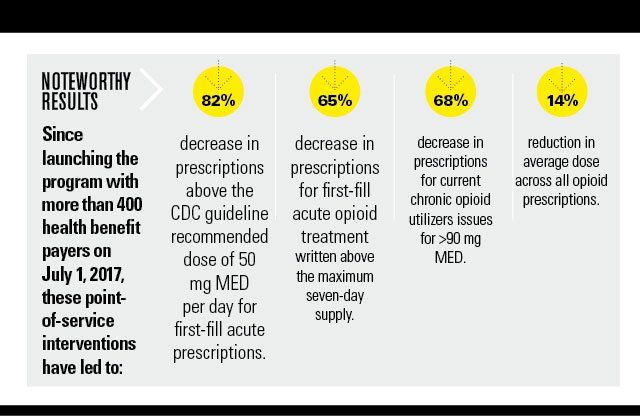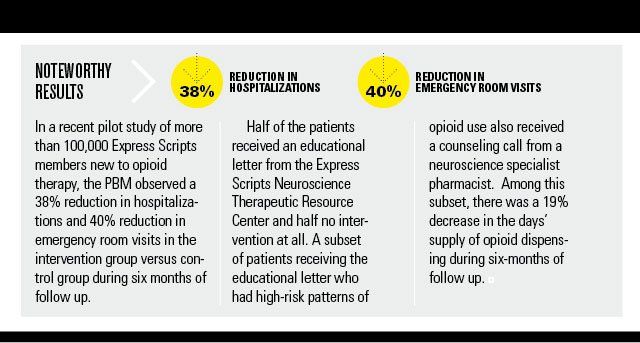Four PBM programs poised to rein in the opioid epidemic
PBMs are in a unique position to help curb opioid abuse. Here are four programs that demonstrate promising outcomes.
Pharmacy benefit managers (PBMs) are well suited to address the opioid epidemic-and, it’s imperative that they do so, according to industry experts.
“PBMs are uniquely positioned to connect and partner with physicians, pharmacists, patients, pharmaceutical manufacturers, health systems, and other components of the industry, and therefore are better able to drive improvements in education surrounding the dangers of opioid therapy, as well as the various tools available for constituents to positively change the course of this epidemic,” says Managed Healthcare Executive Editorial Advisor David Calabrese RPh, MHP, OptumRx’s chief pharmacy officer. “Our nation’s indiscriminate prescribing, dispensing, demand for, and consumption of prescription opioid drugs has led to a scenario in which we now consume more than 80% of the world’s supply of prescription opioids and a corresponding death toll due to opioid overdose which is one of the highest in the world,” says Calabrese.
Here are four PBM programs that demonstrate promising outcomes:
1. OptumRx’s opioid risk management program
This program addresses the epidemic using a connected clinical strategy comprising clinical capabilities and analytics, as well as care management and behavior tools. It targets:
• Prevention and education;
• Minimizing early exposure;
• Reducing inappropriate supply;
• Treating plan participants who are at risk and high risk; and
• Supporting chronic populations and recovery.
“What makes Opioid Risk Management most unique is how we leverage tools and resources that extend beyond traditional PBM-only core capabilities,” says Calabrese, noting that due to the PBM’s affiliation with Optum, a technology-enabled health services business, it is easier to take a deeper dive into data and analytics.

The tools that deliver the most immediate and impactful change are point-of-service utilization management edits that align with CDC best practice guidelines, says Calabrese. These include limitations on the daily morphine-equivalent dose (MED) and the days’ supply of an opioid prescription. These also include limits on the daily MED dose of opioid prescription drugs for chronic utilizers at both an individual drug level and at a cumulative (across opioid prescriptions) level. Finally, these include edits that block opioid prescriptions from processing if a physician has lost controlled drug prescribing authority via the DEA or other entity, and drug utilization screening for dangerous combinations of opioid drugs and opioids with other therapies.
“All of this is designed to decrease unnecessary exposure to prescription opioid therapy that can lead to future dependency and overdose risk in these individuals,” Calabrese says.
Next: Prime's controlled substance management program
2. Prime Therapeutics’ controlled substance management program
Prime’s program is grounded in its industry-validated controlled substance score, which has garnered the interest of government agencies and healthcare organizations nationally and helps identify risk of potential opioid misuse, says Prime’s senior vice president, chief medical officer Jonathan Gavras, MD. “It helps us get to the members who are at highest risk and intervene before a tragic outcome occurs,” he says.

The controlled substance score is calculated using a three-month period of prescription claims data and is divided into three components:
1. The controlled substance score counts the number of controlled substance claims and assigns 0.5 points for the first eight controlled substance claims and then one point for each additional claim.
2. The number of unique pharmacies and unique prescribers are counted and assigned points; one for the first two unique entities and 1.5 for each unique entity thereafter.
3. Points are assigned if the number of controlled substance claims in the third month of the quarter is two or more than in the second month.
Prime’s “controlled substance score” methodology is publicly available for other healthcare organizations to use.
The controlled substance management program also includes:
· Prescriber outreach when patients have a high “controlled substance score.”
· Point-of-sale alerts, which notify pharmacists of potential concerns.
· Prior authorizations and quantity limits.
· Direct member interventions and enrollments in pharmacy homes or single prescribers.
· A team dedicated to examining integrated medical and pharmacy data to analyze program outcomes.
“As a pharmacy benefit manager that is highly integrated with our Blue Plan clients across the country, we are uniquely positioned to use both pharmacy and medical data to identify controlled substance/opioid misuse,” Gavras says. “We see the repetitive claims, the multiple prescribers and pharmacies, and provide a complete tool set for prescribers and pharmacists to help us address potential misuse and even prevent it from occurring in the first place.”
The next phase of the program is to develop a predictive modeling tool, which will launch shortly after press time, Gavras says. “This tool will help further reduce controlled substance misuse by identifying individuals who are early in their opioid use and have characteristics similar to those known to have levels of unsafe use,” he says. “Prime can then work upstream with prescribers and help educate members on dangers so misuse can be avoided before it ever starts.”
Next: Express Scripts' solution
3. Express Scripts’ advanced opioid management solution
This program is designed to lower risk of overuse and abuse at three critical touchpoints.
1. At the pharmacy. This touchpoint includes:
• Restrictions for first-time users of short-acting opioids to an initial fill days’ supply of seven days.
• Enhanced prior authorization for all long-acting opioids to block fills for new users.
• MED edits giving visibility to and requiring prior authorization for members accumulating quantities of opioid medication exceeding 200 mg morphine equivalent dose/day.
• A concurrent drug utilization review to ensure opioid prescriptions are appropriate and medically necessary.
2. With physicians. “We send automated messages directly to all opioid-writing physicians at the point-of-care via their electronic health/medical records portal to inform them of potential duplicate therapy, misuse and abuse, drug-drug interactions, use of multiple prescribers or pharmacies-or when their patient is approaching morphine equivalent dose thresholds,” says Snezana Mahon, PharmD, vice president of clinical product development at Express Scripts.
3. With patients. This touchpoint includes:
• An educational letter sent after the first fill to educate members of the serious potential risks of opioid use, safe handling instructions, important restrictions, and proper disposal of unused medication.
• Proactive outreach to patients by opioid neuroscience specialist pharmacists. Outreach is triggered when data signals concerning patterns of use, for example, filling two or more different short-acting opioids within the last 30 days.
• Distribution of deactivation disposal bags to first-time opioid utilizers who Express Scripts data indicate are likely to have leftover medications. The bags include clear instructions for handling and disposal in members’ homes-no driving or special disposal day required.
• Limiting patients to one prescriber and one pharmacy when certain alerts are triggered.
“Driving change in the opioid crisis requires addressing the full care continuum, and influencing behavior at every touchpoint,” says Mahon. “Drug utilization management alone is not the answer. To impact care and costs, doing the minimum won’t do anything. Simply put, plan sponsors need a treatment plan, not a bandage.”

Next: CVS' enterprise initiative
4. CVS Health enterprise initiatives
CVS Caremark, CVS’ PBM, will roll out an enhanced opioid utilization management approach for all commercial, health plan, employer and Medicaid clients as of February 1, 2018 unless the client chooses to opt out. This effort will leverage the CVS Pharmacy retail presence in nearly 10,000 communities across the country, and it will include:
• An expanded drug disposal collection program to 1,550 units with addition of kiosks at 750 retail pharmacies nationwide, adding to 800 units previously donated to law enforcement.
• Enhanced opioid utilization management aligned with the CDC Guideline for PBM clients and members, complementing measures already in place. Pharmacists will counsel patients about the risk of dependence and addiction tied to duration of opioid use, the importance of keeping medications secure in the home, and methods of proper disposal of unused medication.
• A $2 million commitment by the CVS Health Foundation adding to previous investments in mitigating prescription drug abuse with support for Community Health Centers providing medication-assisted treatment and other addiction recovery services.
“Our goal is to ensure that patients receive the clinically appropriate medications for the condition for which they are being treated,” says Larry Merlo, president and CEO of CVS Health. “In an ankle sprain or a dental procedure, while an individual may be in pain, it doesn’t call for a prescription with quantities of 30 pills or 60 pills of what has been proven to be what is very, very powerful and potent medications.”
David Calabrese of OptumRx Talks New Role, Market Insulin Prices and Other Topics 'On His Mind'
April 13th 2023In this month’s episode of the "What's On Your Mind podcast," Peter Wehrwein, managing editor of MHE connects with the now Chief Clinical Officer of OptumRx Integrated Pharmacies, David Calabrese. In this conversation, David touches on his transition in January as OptumRx’s former chief pharmacy officer and market president of health plans and PBMs to his new role as Chief Clinical Officer where he now focuses more on things such as specialty pharmacy to home delivery — with an overall goal of creating whole-patient care. Throughout the conversation, Calabrese also touched on the market’s hot topic of insulin prices and behavioral health services within the OptumRx community, among other topics.
Listen
Upended: Can PBM Transparency Succeed?
March 6th 2024Simmering tensions in the pharmacy benefit management (PBM) industry have turned into fault lines. The PBMs challenging the "big three" have formed a trade association. Purchaser coalitions want change. The head of the industry's trade group says inherent marketplace friction has spilled over into political friction.
Read More
Briana Contreras, editor of Managed Healthcare Executive, spoke with Nancy Lurker, CEO and president of EyePoint Pharmaceuticals. Nancy shared a bit about EyePoint and how the organization’s innovative therapies are addressing patient needs through eye care, and most importantly, she addressed C-Suite positions like the CEO role. Nancy shared advice for those seeking to reach the CEO level, especially toward women in healthcare and other roles, and what it takes to run a biopharma company.
Listen
The deliberate disconnection of Change Healthcare to ring fence a cyberattack entered its seventh day today. Prescribers are finding ways to get pharmacy claims processed, and UnitedHealth Group says disruption to the dispensing of prescriptions has been minimal. But independent pharmacies want more information and protection from financial consequences from pharmacy benefit managers.
Read More